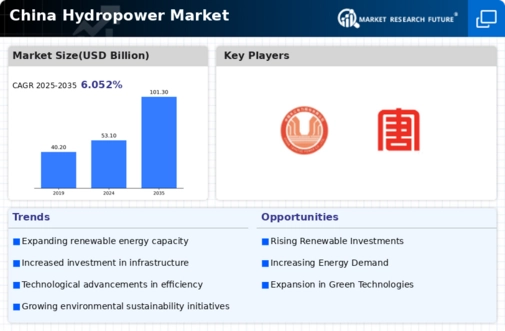Rising Energy Demand
The increasing energy demand in China is a primary driver for the hydropower market. As the economy continues to grow, the need for sustainable and reliable energy sources becomes more pressing. In 2025, China's energy consumption is projected to rise by approximately 3.5% annually, necessitating the expansion of renewable energy sources, including hydropower. The hydropower market is expected to play a crucial role in meeting this demand, as it provides a stable and efficient energy supply. Furthermore, the government has set ambitious targets for renewable energy, aiming for hydropower to contribute around 20% of the total energy mix by 2030. This focus on hydropower is likely to drive investments and development in the sector, enhancing its capacity and efficiency.
Technological Innovations
Technological innovations are transforming the hydropower market in China, enhancing efficiency and reducing costs. Advances in turbine design, automation, and digital monitoring systems are enabling hydropower plants to operate more effectively. In 2025, it is estimated that the implementation of smart grid technologies will improve energy distribution and management, allowing for better integration of hydropower into the national grid. Moreover, innovations in small-scale hydropower systems are making it feasible to harness energy from smaller water sources, expanding the potential for hydropower development in rural areas. These technological advancements not only increase the competitiveness of the hydropower market but also contribute to the overall sustainability of China's energy landscape.
Government Support and Policies
Government support and favorable policies significantly influence the hydropower market in China. The Chinese government has implemented various initiatives to promote renewable energy, including hydropower, as part of its commitment to reducing carbon emissions and combating climate change. In 2025, the government aims to increase the share of renewable energy in the national energy mix to 50%, with hydropower being a key component. Financial incentives, such as subsidies and tax breaks for hydropower projects, further stimulate investment in the sector. Additionally, the government has established a regulatory framework that facilitates the development of new hydropower plants, ensuring that the hydropower market remains attractive for investors and developers alike.
Regional Development and Urbanization
The rapid urbanization and regional development in China are significant drivers of the hydropower market. As cities expand and populations grow, the demand for energy in urban areas increases. In 2025, urban areas are expected to account for over 60% of China's total energy consumption. This trend necessitates the development of reliable energy sources, with hydropower being a key player. The government is investing in infrastructure projects that include hydropower plants to support urban growth and ensure energy security. Additionally, regional development initiatives aim to harness local water resources for hydropower generation, further bolstering the hydropower market's role in meeting the energy needs of a rapidly urbanizing population.
Environmental Sustainability Initiatives
Environmental sustainability initiatives are increasingly shaping the hydropower market in China. As the country grapples with pollution and environmental degradation, there is a growing emphasis on clean energy sources. The hydropower market is viewed as a viable solution to reduce greenhouse gas emissions and promote sustainable development. In 2025, it is anticipated that hydropower will help offset approximately 300 million tons of CO2 emissions annually. This aligns with China's broader environmental goals, including achieving carbon neutrality by 2060. The commitment to sustainability is likely to drive further investments in hydropower projects, as stakeholders recognize the importance of balancing energy needs with environmental protection.













Leave a Comment